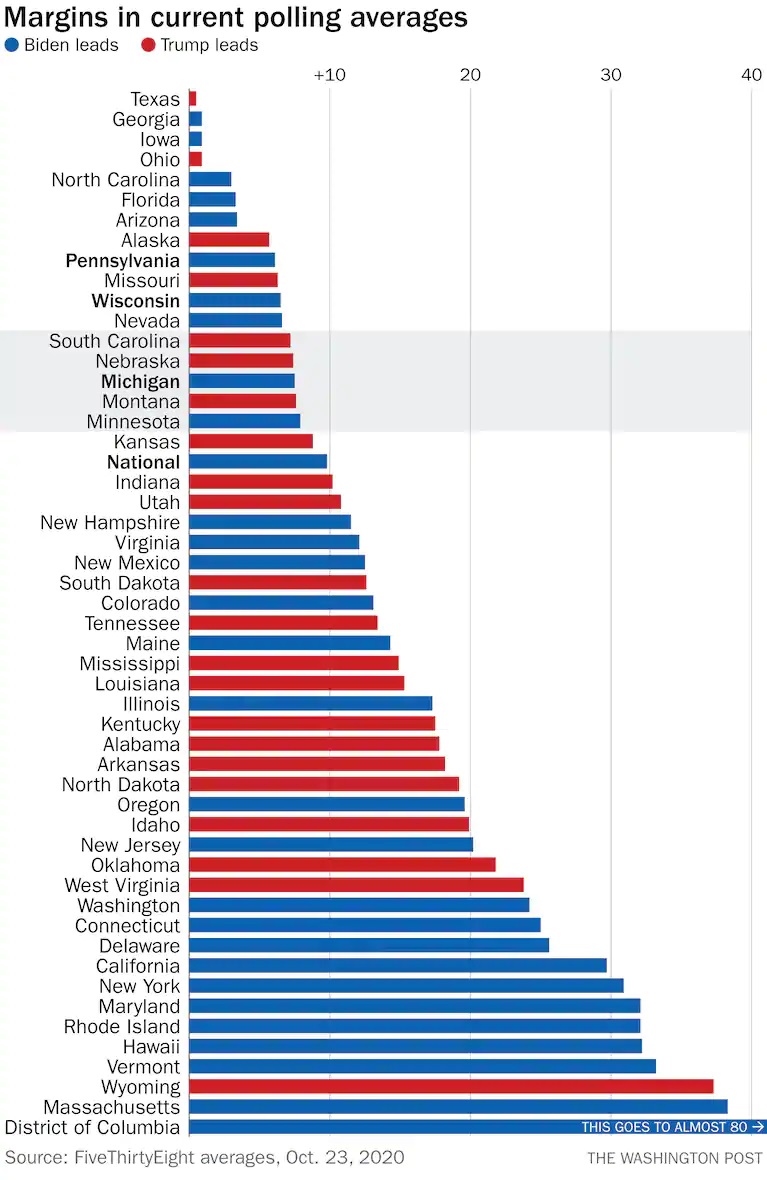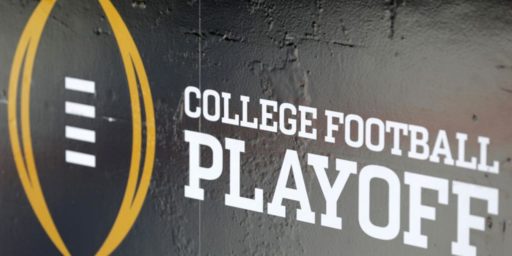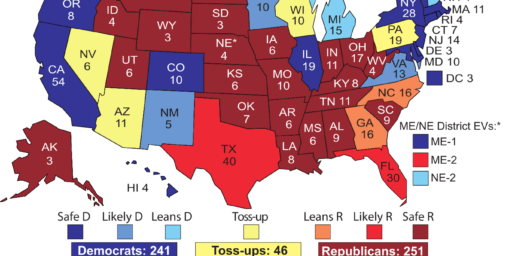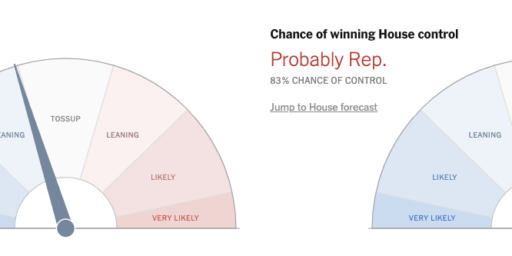Could Biden Win Texas and Lose Ohio?
The state polling is not lining up along usual patterns.
Philip Bump observes that “The electoral map is very weird right now.” He’s not wrong. Joe Biden has big leads in what are ordinarily swing states while the margins are tight in states that are usually runaways.
He uses FiveThirtyEight aggregate polling data to rank states in order of closeness:

The state that’s closest at the moment is — Texas. If Joe Biden wins Texas, it’s over.
But it doesn’t get less weird. Georgia, Iowa and Ohio — which Trump won in 2016 by five, nine and eight points, respectively — are the next three closest states. What’s more, Biden leads in the first two.
Notice where Pennsylvania, Michigan and Wisconsin land. In 2016, Trump’s narrow wins in those three states earned him the presidency. Now, Biden leads by at least six points in each. Arizona is closer than any of those three states. Alaska is closer.
We highlighted a particularly odd stretch of margins. South Carolina is closer than Michigan? Michigan is closer than Montana? Nebraska is closer than Minnesota? What is happening here?
We must of course note that polling a bit over a week before the 2016 election also showed Trump trailing in key states by fairly wide margins. All of those states that are narrower than Arizona are within about three points — a margin that could be within a normal polling error range.
Well, no. The whole point of using aggregates rather than single polls is to smooth out sampling error and house effects.
Weirdness is one state wouldn’t be that hard to explain. Maybe there’s a major demographic shift or some issue (like, say, fracking) idiosyncratically important there.
But, yes, one would expect that, if Biden is leading in Georgia and within striking distance in Texas that he would be running away with the swing states in the Rust Belt.
Regardless of the weirdness, Bump concurs with the conventional wisdom that Biden is in the driver’s seat and that Trump pulling out a surprise win again is next to impossible.
As of writing, the average shift across the swing states in the past week (setting aside Nebraska) was about a quarter of a percentage point toward Trump. During the same period in 2016, the polls had shifted an average of a point toward Trump. The problem for Trump is that he trails now by an average of 4.3 points in these states, while he was down only 2.5 points then.
A lot can change, in theory — but it hasn’t so far. This race has been remarkably static. Trump was able to gain ground four years ago in part because many voters still hadn’t made up their minds. That’s less the case now: Most Americans have very strong opinions about Trump and whether he deserves a second term. There’s less room for Trump to pick up support without Biden losing any, and so far that hasn’t been happening.
So, who knows. Maybe Montana will be closer than Michigan. If it is, it’s easy to guess who will be president next January.
Of course, this is all “weird” and “unusual” because we have a really odd way of selecting the President of the United States. If we simply tallied up who received the most votes from American citizens, it would be interesting only to political scientists and demographers where people happened to live. But, in our system, it matters very much indeed.






The explanation as to why Texas and Georgia and not Ohio, PA and IN is that the growth of TX & GA has urban/suburban areas of those states more closely resembling the west coast and the northeast corridor in economic and social view that is reflecting in political choices. While the rust belt states are fairly static in growth and are being left behind by the changing economy. These trends have been ongoing for several election cycles, but Trump and the R’s revanchist lurch over the past 4 years has accelerated a trend that was predicted for the end of the decade.
Another way to look at it is that TX and GA are where Virginia and North Carolina were in 2008
Amazing, the page reloaded automatically and the edit function and HTML buttons appeared w/o a manual reload.
This year is unusual enough that all the polls may be way off.
Take a look at youth turnout:
https://twitter.com/ASE/status/1319818684005756928
Another polling tidbit:
https://twitter.com/NateSilver538/status/1319819274668605441
@Sleeping Dog: This about sums it up.
Sometimes I like looking at historical election maps just to amuse myself about a time when CA and Florida had 6 electoral votes and Ohio had nearly 30. Demographics are destiny, but so are migration patterns–at least in our antiquated Electoral College system
@Sleeping Dog: There’s no doubt that in-migration explains part of what’s happening in Texas. Still, they last voted Democratic in 1976 and it really hasn’t been close since.
2016 D 43.25, R 52.2% (9 points)
2012 D 41.4%, R 57.2% (16 points)
2008 D 43.7%, R 55.5% (12 points)
2004 D 38.2%, R 61.1% (23 points)
2000 D 38.0%, R 59.3% (21 points)
@James Joyner:
Texas isn’t a “Red State” it’s a non-voting state. They are constantly in the lower 5 states in voting. What you’re seeing are very angry young people awakened from apathy that want to destroy the party that has laughed at the existential threats of the 21st century while calling them ‘snowflakes’
The olds have seen the GOP dismiss their concerns over COVID and literally say that they should die in a basement so that some dentist from Ohio can bring his clan to Florida to visit Disney and eat a cheeseburger without being reminded that we’re in a pandemic.
@James Joyner:
I don’t believe we have much of a disagreement, I was looking for an explanation, that I concede may be wrong, but it makes sense. A trend that is in progress plus an accelerant has some logic. Going into this election, if you would have told me that the Dem would be up in GA and nipping on Trumps heels in TX, all w/in the margin of error, I would wonder what was in the water of VA.
@charon: link showing 18-29 turnout already this year is certainly a factor in this weirdness.
@Arm The Homeless: it’s also known as one of the hardest states to vote in.
As a bonus, those numbers James posts are on an obvious downward trend, and white steeply. In 16 years, from 2000-2016, Rs lost 12 points overall, with a very high variance in between. It’s no shock that a wave election would overwhelm that decaying support. In 8 years we should expect a “neutral” election to be 50/50 in Texas, and if tends continue, in 2032 it will be a wholly blue state.
@ptfe:
Indeed. It’s considered impolite to point out that the modern Conservative movement has given up on democracy and instead has pinned their hopes on packing the courts and supressing voters they deem hostile to them at the state level.
Anywhere growing with younger people and more sprawl or density will end up being a Democratic state. Unless something changes, that is. For people under 45, the Democrats are the party of both conservative thinking and liberalism. It’s basically like NYC writ large minus Staten Island where you have an incredibly diverse set of voting groups all of whom are reliable Democratic voters. You have 8th-gen wealth people with 3rd homes living on the UES and black renters in Flatbush with 3rd jobs as Uber drivers all just voting the same.
@Modulo Myself:
Writers describe a once-upon-a-time where the Republican and Democratic parties largely overlapped on policy and conflict was adjudicated within the parties, not in general elections. This was way back in the 50s and 60s, before civil rights, before FOX, and before Newt Gingrich. In my optimistic moments I think maybe the Republicans will fade into a neo-Confederate/libertarian Southern and rural rump, and like within NY or CA, national policy will be made within the Democratic Party. This years D primaries adjudicated some fairly large policy differences. (Not as large, I think, as the supposedly liberal MSM liked to make out. They do love their Dems-in-dissarray stories.)
In my more realistic moments I expect the GOPs to play divide and conquer by welcoming Hispanics, or at least White Hispanics, per their 2016 post-mortem. And I expect that Chuckles, the remaining Koch Bro, will move to get control of the R nominating process. They can still compete, I think, with a lovable buffoon like W as a front man instead of the repellant buffoon the primaries horked up.
@Modulo Myself:
That shouldn’t be a surprise as the Dem tent is much larger than the R tent. If you ignore what Conservatism means in America and use an European filter where Conservative parties are seen as advocates of Classical Liberalism, market economies and incremental social change, then the moderate wing of the Dems is the conservative party, especially when you look at the R’s who have become revanchist and nationalist.
@Arm The Homeless:
I suspect that their voting rate is so low precisely because the election outcomes are typically a foregone conclusion.
I mean, maybe. But if that’s the case, we ought to be seeing a true wave election. Biden should be running the table easily in the states Obama carried in 2008, let alone 2012. He’s not.
@ptfe:
I very much agree that Texas is trending purple. But 2000 and 2004 featured a very popular native son on the ballot, so I’m not sure it’s a fair comparison.
@charon:
My word; that youth turnout is incredible!
If it’s like that nationwide, and in all voting, not just early, a lot of polling models are going to be off.
And it has to be going mostly Dem. or you can paint me red and call me a radish.
@Sleeping Dog:
I think the future of the conservative wing of US politics is for Justin Amash to bring in moderate republicans (I think there’s still a few left out there) and take over the Libertarian Party.
Modern Libertarians have some good ideas–socially liberal, fiscally conservative; small government (but not anarchy); free but not uncontrolled markets–but they keep nominating idiots. And they have to clearly distance themselves from Ayn Rand (she does not describe how modern libertarians think).
If Amash stepped up, I can see a lot of Republicans following along.
AOC becomes the left, Biden becomes the center, and Amash becomes the right. Trump and McConnell become embarrassing extremists.
@James Joyner: holy shit those numbers show drastic Republican decline.
@Mu Yixiao:
I suspect that the anti-Trump Rs would welcome such a party. Here in NH, the libertarians run as Rs and have had a moderating influence on the Christianist wing of the party, while at the same time pulling the R’s to the right on economic and environmental issues.
Yes, Libertarians can be players, but only if one of two things happened, they stayed in alliance with the trumpists or split moderate Dems and anti-trump Rs from from the Dems. While the anti-trump Rs want a viable political home and probably won’t find it with Dems, I’m not sure of the motivation of moderate, lifetime Dems to leave the party. After all the AOC/Bernie wing is only about 30% of the parties membership and pretty consistently the moderates prevail over the left. Much to the chagrin of the left.
I want to offer another theory, which I’m not sure I believe in, or how much I believe in te: only losers are voting Republican.
Ohio’s economy has been in decline for ages, along with much of the Midwest. A revanchist call to “Make America Great Again” appeals to them because things suck now. Texas and Georgia have been booming.
Obviously that oversimplifies things, and most people vote a party based on habit, and there are other issues like massive plagues… but it could be a factor.
Just spitballing here. It would definitely be in the Democrats’ interest to have a national industrial policy that helps the Midwest which can be implemented when they are in power. Meanwhile, the Republicans would have an incentive to govern badly…
@James Joyner: This month’s Texas Monthly takes a deep dive into what is going on there. I recommend it highly.
(I’ve been reading them for a while now and finally subscribed to them 3 months ago. While they have a leftward bias, when it comes to politics they are data driven and very even handed in their reporting. Plus, they have a bunch of great writers who really know how to spin a yarn.)
I also think some pundits get stuck in the past when evaluating the relative partisan tendencies of states, even though these things change over time. For example, by late-20th-century standards the idea of a Dem winning VA while losing WV would have seemed distinctly weird–yet it’s become the norm since 2008. We shouldn’t be surprised to see further shifts in the future.
@Arm The Homeless:
It is harder to vote in Texas than in any other state. 50 of 50.
The Supreme Court gutted the VRA for a reason.
@Mu Yixiao:
Reason is the most neutral point for Libertarianism on line.
Their blog – Hit & Run is over-run and awash by the right-most elements. Reactionary. LINO shit.
Rs captured big L libertarianism.